K8NHA Pro layout and features
NVIDIA chooses to run with a single chip for bridging duties. That's one of the hallmarks of the nForce3 150. We must remember that NVIDIA, like VIA, can use the nForce3-series for both the FX-5x / Opteron and Clawhammer CPUs. The former version is recognised as the nForce3 Pro 150.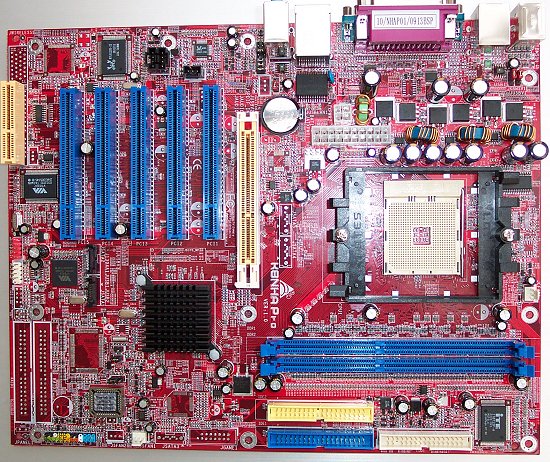
The K8NHA Pro, on first glance at least, seems to be less crowded than the VIA interpretation. That, of course, is helped by having on a single chip control both the usual North and South bridge duties.
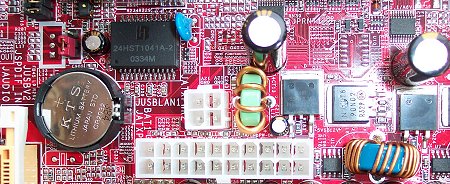
Here, though, Biostar elects to group the power ports in an awkward location, slap in the CPU fan's airflow. We can't quite fathom why this needs to be the case. One might be fine if an Enermax, with its 6-feet-long cabling, PSU is used. Our test PSU, a quality Samcheer 420w model with adjustable pots., had to have its 20-pin main power cable run over the test Zalman heatsink's fan. That's poor design thought from Biostar. It also seems to be a fan of location the motherboard's battery in weird and wonderful places. The VIA version had it sandwiched between floppy and IDE ports. Here it resides just above the AGP port. The associated clear CMOS jumper is on the other side of the board, just below the nForce 150 chip.
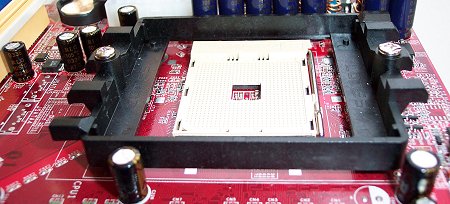
If you've never seen a Socket-754 retention bracket close-up, here it is. Coolers can either affix via the three lugs on either side and then use a locking mechanism of sorts or they can screw into the plastic bracket through the two screws that hold it on to a backplate. We're ambivalent. Either method works and works well. We're also glad that the A64 has decided to don a heatspreader.
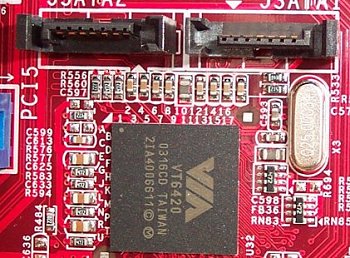
VIA, how ironic, provide the PCI-based SATA controller in the form of the VT6420. It's much like the native VT8237 SATA controller in most respects. It's featured in 2 SATA port mode here, so it offers independent, RAID0 and RAID1 support. Like the '8237, it can use another 2 SATA drives via a compliant PHY, and then offer 4 drives capable of RAID0+1. Its limitations against on-chip support are plain to see. The pesky PCI bus will begin to throttle the available bandwidth at 133MB/s. That's fine for single-drive usage, but may not be so for high-speed RAID runners. There's also 2-port FireWire, again from VIA, sandwiched between the PCI and CNR slots.

Here's our problem with the relative positions of the AGP and first PCI slot. A half-height SMC Ethernet card is placed in the first PCI slot. It heavily compromises the ATI fan's cooling ability. A standard card would block of airflow almost completely. Sure, you can use other PCI slots, but then why provide 5 when one is almost unusable with GPUs that require active cooling ?.
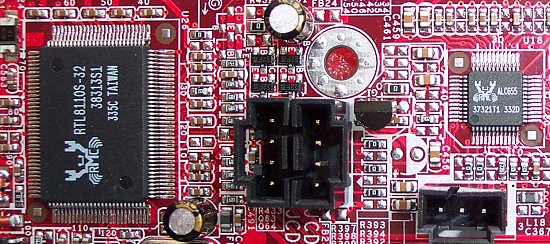
Gigabit LAN is specified here too. Unlike Intel's MCH-attached CSA architecture, AMD, NVIDIA and VIA will have to use PCI-based solutions until it's incorporated into the chipset itself. The ALC655 CODEC is actually a rung lower down on Realtek's scale than the incumbent '650. Its lower bit accuracy shouldn't really be too much of a hindrance for onboard software-accelerated AC'97 sound. We'd prefer the '658, of course. Biostar does the right thing with S/PDIF support through a supplied cable.
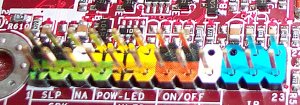
Just a small shot here highlighting attention to detail. It's often difficult to work out which pins do what when the surround area is coloured the same. We like individual colours for the various motherboard-to-case pins. It's simple and effective. That's what good design usually is. If you look back at the first picture and focus your attention on the CNR slot, you'll see that PCB space is unused behind it. That would be the location for the Wi-Fi slot. It's the same for the VIA K8T800. Wireless LAN is an optional extra on both boards. It's about time that it became standard on deluxe boards, much in the vein of ASUS and its serious Wi-Fi support









